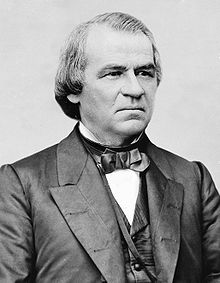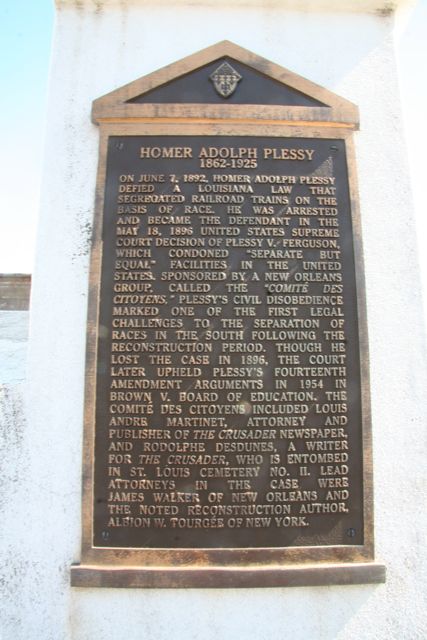|
Words by Anthony Ruggiero At the end of the Civil War, throughout the Reconstruction Era and onwards, there existed - and still exist - unresolved racial issues. In the subsequent Reconstruction era, distribution of land within the southern states was ineffectively handled, with both black and white southerners being forced to share, resulting in black citizens becoming financially dependent on wealthier merchants. Furthermore, an increasing racial divide surfaced as a result of the Jim Crow laws as well as other policies and groups, halting the economic, societal, and political progress of black citizens. Although in today’s society some progress has been made, there still exist lurking racial issues that are legacies of the Civil War. President Andrew Johnson One of the issues that went unresolved at the end of the Civil War was land redistribution and former slaves’ inability to support themselves economically. Although former slaves were promised land within the South at the end of the Civil War, President Andrew Johnson’s 1865 federal order returned land to the old plantation owners. Many African Americans therefore had to sharecrop the land, which often led to long leases and other problems. For example, black farmers were unable to acquire the equipment needed to work their farms independently.[1] Thus, farmers were forced to use their crops to pay off white southern merchants in order to gain a loan to pay for the necessary supplies. This system effectively ‘bound the farmer to the merchant and restricted his options to buy elsewhere or dispose of his crop in the most advantageous manner.’[2] In order to pay back the loan, farmers focused on growing a cash crop such as cotton. However, farmers would often neglect growing crops for food production, thus forcing them to borrow more money from the merchants to feed their families.[3] Another unresolved issue was protecting the rights of black citizens throughout reconstruction. Although former slaves were formally recognize as citizens and could vote under the Constitution, these ‘new’ citizens faced further obstacles in the form of the Jim Crow laws, and subsequent “black codes.”[4] Implemented within the south, these laws highlighted the racial divide between white and black citizens, by mandating separate sections within restaurants, prohibiting black mobility in businesses, and literacy exams in order to vote.[5] Furthermore, black citizens were singled out by law enforcement, due to the existing racial stereotypes describing black citizens as unlawful, and placed within the convict lease system. This meant that black citizens were forced to work, under harsh conditions and were subject to beatings by prison guards, in areas such as mining.[6] This system was called ‘convict leasing’. Prisons were allowed to do this under a clause within the Thirteenth Amendment which stated, "neither slavery nor involuntary servitude, except as a punishment for crime whereof the party shall have been duly convicted, shall exist within the United States, or any place subject to their jurisdiction."[7], thus effectively placing them back into a system of slavery. Furthermore, this time period emphasized the doctrine of “separate, but equal”. For example, the 1896 Supreme Court case, Plessy v. Ferguson, highlighted this issue when the United Sates Supreme Court ruled in favor of the New Orleans Committee of Citizens, once Homer Plessy had sued after he had been arrested for not sitting in a segregated car. This era was marked by its de jure racial segregation policies[8]. In addition, anti-black groups, such as the Ku Klux Klan, would murder and torture black citizens.[9] Deadwildcat at en.wikipedia [CC BY-SA (https://creativecommons.org/licenses/by-sa/3.0)] In today’s society, there still exists a racial divide within US society . Although there has been progress after the height of the civil rights movement of the 1960s regarding blatant racial segregation, there still remains a gap between white and black citizens across a number of areas. For example, the black middle class has grown only to approximately ten percent of all black households; the unemployment rate remains twice that of whites, with no real push to resolve this issue. [10]Furthermore, a racial divide still remains within the United States prison system. According to research made by Ohio State University Professor, Michelle Alexander, “there are more blacks in the correctional system today in prison or jail, on probation or parole than in slavery in 1850”[11]. In addition, black citizens are more likely to be singled out, due to racial profiling, as being more likely to commit crimes than their white counterparts.[12] Furthermore, ‘convict leasing’ is also a reoccurring issue within the prison system. In 2016, 24,000 prisoners within 29 prisons in 12 states protested against inhumane conditions[13]. In 1979, The Federal Bureau of Prisons, backed by the United States Congress, created a program called the Federal Prison Industries (UNICOR) in order to tackle the downturn of inmates, and thus the lack of revenue[14]. The program paid inmates under one dollar an hour. States, such as Virginia and Oklahoma, targeted and utilized specifically African Americans and Latinos within the program[15]. Overall, the program generated an estimated $500 million in sales, the profits of which were not shared with the workers[16]. As a result, prisoners staged a coup against the system in the form of a strike. Despite this large-scale strike, this system is still utilized through congressional loopholes, thus promoting a new form of slavery. While the Civil War accomplished the reuniting of two parts of the nation, unresolved issues resulted in a division between its citizens. The United States government’s ineffective strategy in land redistribution was detrimental to black citizens who further felt the economic hardships during Reconstruction. Furthermore, the racial tensions that were created thereafter greatly, and negatively, affected black citizens. As a result, many black US citizens feel that racial divide as keenly today in the twenty-first century as they did one hundred years ago.  Anthony Ruggiero is currently a High School History Teacher in New York City, New York. In addition to teaching, he has been published in several magazines, such as History Is Now, Historic-UK, Tudor Life, Discover Britain, and The Odd Historian. Anthony has also written for the Culture-Exchange blog, and The Freelance History Writer blog. His work can also be viewed on his Twitter handle: @Anthony10290122 [1] Douglas-Bower, Devon. Debt Slavery: The Forgotten History of Sharecropping I The Hampton Institute. November 7, 2013. http://www.hamptoninstitution.org/sharecropping.html.
[2] Debt Slavery: The Forgotten History of Sharecropping. [3] Ibid. [4] Jim Crow (article) | Period 6: 1865-1898. Khan Academy. https://www.khanacademy.org/humanities/ap-us-history/period-6/apush-south-after-civil-war/a/jim-crow. [5] Jim Crow (article) | Period 6: 1865-1898. [6] Douglas-Bower, Devon. Slavery by Another Name: The Convict Lease System I The Hampton Institute. 2013. [7] Slavery by Another Name: The Convict Lease System. [8] Jim Crow (article) | Period 6: 1865-1898. [9] Ibid. [10] Oskin, Becky. Why US Still Needs a Civil Rights Movement. LiveScience. August 29, 2013. http://www.livescience.com/39291-america-still-needs-civil-rights.html. [11] Why US Still Needs a Civil Rights Movement. [12] Ibid. [13] Love, David A. Slavery in the US Prison System. Prisons | Al Jazeera, Al Jazeera, 2017. [14] Love, Slavery in the US Prison System. [15] Ibid. [16] Ibid.
0 Comments
Leave a Reply. |
Categories
All
Archives
April 2024
|


 RSS Feed
RSS Feed